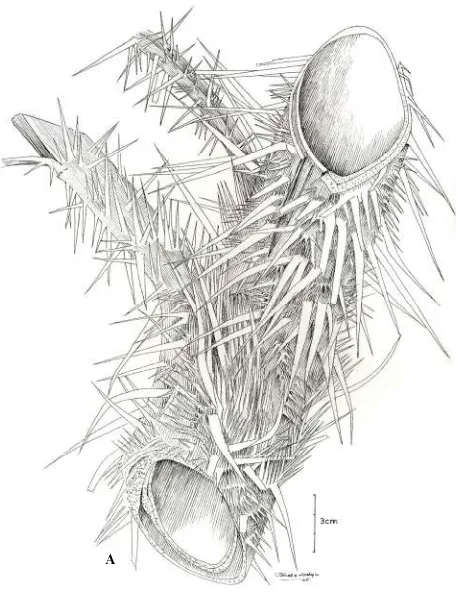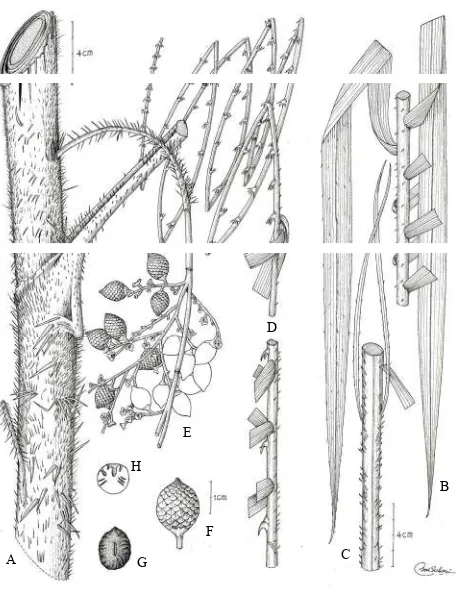REINWARDTIA
Vol 13, Part 1, pp: 25 − 30
25
TWO NEW SPECIES OF DAEMONOROPS FROM SULAWESI
Received June 8, 2009; accepted June 16, 2009
HIMMAH RUSTIAMI
Herbarium Bogoriense, Botany Division, Research Center for Biology–LIPI, Jl. Raya Jakarta Bogor Km. 46, Cibinong 16911, Indonesia. E-mail: himmah@hotmail.com.
ABSTRACT
RUSTIAMI, H. 2009. Two new species of Daemonorops from Sulawesi. Reinwardtia 13(1): 25–30. — Daemonorops mogeana Rustiami and Daemonorops takanensis Rustiami are described and illustrated for the first time based on specimens collected from Central Sulawesi and South Sulawesi respectively. An identification key of Daemonorops in Sulawesi is constructed in order to differentiate between those two species and other species of Daemonorops in Sulawesi.
Key Words: Daemonorops takanensis, Daemonorops mogeana, Central Sulawesi, South Sulawesi.
ABSTRAK
RUSTIAMI, H. 2009. Dua jenis baru Daemonorops dari Sulawesi. Reinwardtia 13(1): 25–30. — Daemonorops mogeana Rustiami dan Daemonorops takanensis Rustiami dipertelakan dan digambarkan berdasarkan spesimen yang dikoleksi berturut-turut dari Sulawesi Tengah dan Sulawesi Selatan. Kunci identifikasi marga Daemonorops di Sulawesi disusun untuk memperjelas perbedaan kedua jenis baru tersebut dengan jenis-jenis lain yang ada di Sulawesi.
Kata Kunci: Daemonorops takanensis, Daemonorops mogeana, Sulawesi Tengah, Sulawesi Selatan.
INTRODUCTION
In the course of preparing a revision of the Rattans of Sulawesi, which so far consist of five species (Beccari 1911), I came across two peculiar unidentified rattans belonging to Daemonorops. These two species as other five species from Sulawesi, display all the key characteristics of the section Piptospatha, namely the pendulous inflorescence, the prophyll not enclosing whole inflorescence and subsequent bracts falling at anthesis. Herein, I name, describe and illustrate these species, D. mogeana Rustiami and D. takanensis Rustiami. D. mogeana is relatively similar to D. macroptera. In this paper I construct an identification key for whole species of
Daemonorops in Sulawesi.
Key to the species in Sulawesi
1. a. Leaf sheath covered with rusty – brown coloured indumentum and armed with short, up to 10 mm long, easily detached spines ...D. takanensis b. Leaf sheath without indumentum and armed
with long, more than 15 mm long, strongly attached spines... 2 2. a. Leaf sheath armed with brittle, unequal solitary
spines ...…...3 b. Leaf sheath armed strongly with large, irregularly
seriate spines...5 3. a. Leaf sheath armed with solitary, black, brittle
spines; ochrea present ...D. lamprolepis
b. Leaf sheath armed with solitary or in groups of black spines; ochrea absent ...…...4 4. a. Leaf sheath armed with very densely long, solitary,
hair-like spines...D. sarasinorum b. Leaf sheath armed with short, scattered, seriate,
needle like spines ... ...D. riedeliana 5. a. Leaf sheath armed with jointed bases, oblique
spines; fruit spherical, endosperm deeply ruminate ...D. robusta b. Leaf sheath armed with solitary to jointed bases,
upright spines; fruit subglobose to ellipsoid, endosperm slightly to deeply ruminate ...6 6. a. Leaf sheath densely armed with solitary,
furfuraceous spines; fruit ellipsoid, endosperm deeply ruminate ...D. macroptera b. Leaf sheath densely armed with groups of 3’s –
5’s, greyish spines; fruit subglobose, endosperm slightly ruminate ...D. mogeana
Daemonorops mogeana Rustiami spec. nov. ― Fig. 1 & Fig. 2.
Daemonorops macroptera affinis sed vaginis foliorum spinas robustas giganteas ferentibus et fructo acuto non ellipsoideo differt. ― Type: Indonesia, Central Sulawesi, Kab. Poso, District Kulawi, Dusun Moa, Mt. Malemo, 1000 m alt., 21 October 1977, JP Mogea 1356, fruiting specimen (BO-Holo).
REINWARDTIA
26 [VOL.13
sheaths 2 cm in diam.; internodes 20 cm long. Leaf sheaths woody, creamy-yellow, densely armed with numerous broad spines, often with conspicuous bulbous bases, and arranged in groups of 3’s–5’s, flat, greyish, irregularly seriate, 1–7 cm long, 5 mm wide, intermixed with smaller and ascendant spines. Leaves very large up to 6 m long including petiole and cirrus; petiole very robust, 1 m long, 2 cm wide and 1 cm thick at base, rounded adaxially and abaxially, densely armed with, seriate or irregularly, erect, triangular, 1–3 cm long and up to 1 cm wide spines; rachis up to 3 m long, with similar triangular spines; leaflets large, 30 pairs on each side of rachis, regularly arranged, linear-lanceolate, acuminate, armed with small bristles, 5 mm long along the mid nerve on both surfaces and the apex; transverse veinlets conspicuous; middle leaflets 40 cm long; 2 cm broad, papyraceous, green and concolorous; apical leaflets to 20 long, 1.5 cm broad; cirrus to 2 m long, armed with 4–5-hooked grapnels arranged 3 cm apart. Staminate and pistillate inflorescences not known. Infructescence ascending, to about 70 cm long, with 6 erect, very slender, cupressiform, partial infructescences, 5 cm apart; the main axis cylindrical, 20 cm long, armed with dense, glaucous, seriate spines, about 1–5 cm long, with bulbous bases, and covered with blackish brown indumentums; partial infructescence about 15 cm long bearing up to 10 unequal rachillae. Fruit sub globose, covered with 14 vertical rows of glossy yellowish scale, 8 mm long and 4 mm broad. Seed one, globose. Endosperm slightly ruminate.
Habitat and Ecology. This species is common in
Agathis forest, beside streams on the slopes of G. Malemo, 1000 m alt.
Distribution. This species only known from the type locality.
Uses. Young shoot is edible and good.
Vernacular name. Uwi manis (umbut manis)
Etymology. I would like to dedicate this new species to the eminent palm expert from Indonesia Prof. Dr. Johanis Palar Mogea who collected this species during his field work in Sulawesi.
Notes. This species has been identified as Dae-monorops macroptera by Maturbongs (2001) be-cause it is similar to this species morphologically. However after thorough study and careful examina-tion this new species differs from D. macroptera by leaf-sheath armature where it has very robust, gi-gantic spines, fruit subglobose and slightly ruminate endosperm, whereas the latter has gigantic, fragile,
easily broken spines, and ellipsoidal fruit and deeply ruminate endosperm like common Dae-monorops species from Sulawesi.
Specimen examined. Indonesia: Central Sulawesi, Kab. Poso, District Kulawi, Dusun Moa, Mt. Malemo, 1000 m alt., 21 October 1977, JP Mogea 1356, fruiting specimen (BO).
Daemonorops takanensis Rustiami spec. nov. ― Fig. 3.
Neo species of Daemonorops ad sectionem Pipto-spatham recognitus ab Takane-kane collis pertinens sed in spinis vaginae foliorum disposita differt. – Type: Indonesia, South Sulawesi, Kab. Mamuju, District Kaluku, Dusun Roa, Rantai Village, Kaluak, Bukit Takane-kane, 200 m alt., 06 February 1993, Padmi Kramadibrata 028, fruiting specimen (BO-Holo).
Fig. 1. Daemonorops mogeana Rustiami. A. Portion of cane x ½; B. Mid portion of leaf, abaxial view x ½; C. Leaf tip and cirrus x ½; D. Portion of infructescence x ½; E. Fruit x 1; F. Seed x ½; G. Seed in longitudinal section x ½. After J.P. Mogea 1356, drawn by Iskak Samsudin.
C
A E
F G
B
REINWARDTIA
28 [VOL.13
Fig. 2. Daemonorops mogeana Rustiami. A. Leaf sheath armature. After J.P. Mogea 1356, drawn by Iskak Samsudin and Wahyudi Santoso
Fig. 3. Daemonorops takanensis Rustiami. A. Portion of leafsheat x ½; B. Mid portion of leaf, abaxial view x ½; C. Basal portion of leaf x ½; D. Leaf tip and cirrus x ½; E. Portion of infructescence x ½; F. Fruit x 1; G. Seed x 1; H. Seed in longitudinal section x 1. After Padmi Kramadibrata 028, drawn by Subari.
D
E
A
G
F
B
REINWARDTIA
30 [VOL.13
Distribution. Known from the type locality only.
Habitat and ecology. Disturbed primary forest on hill slope.
Uses. Not recorded.
Vernacular name. Rotan Api.
Etymology. The epithet name is after the locality Takane-kane where the plant was collected.
Notes. This new species can be recognized easily by its leaf sheath dark green, covered with conspicuously rusty – brown coloured indumentum and armed with numerous very brittle, thin laminar, unequal, up to 1 cm long or even shorter, solitary, scattered, easily to detached, brown spines, with small bulbous bases. So far this species is only known from the type locality, Bukit Takane-kane.
Specimens examined. Indonesia, South Sulawesi, Kab. Mamuju, District Kaluku, Dusun Roa, Rantai Village, Kaluak, Bukit Takane-kane, 200 m alt., 06 February 1993, Padmi Kramadibrata 028, fruiting specimen (BO).
ACKNOWLEDGEMENTS
I would like to thank the STORMA IPB for part sponsorship of my study. I would also like to thank Dr John Dransfield and Dr Johanis Palar Mogea for their wise guidance during preparation of the manuscript and the revision of Daemonorops in Sulawesi. I should like to thank Prof. Dr. Mien A. Rifai for reading the first draft. Mr. Iskak Samsudin, Mr. Sobari and Mr Wahyudi Santoso, of Herbarium Bogoriense prepared the figures.
REFERENCES


